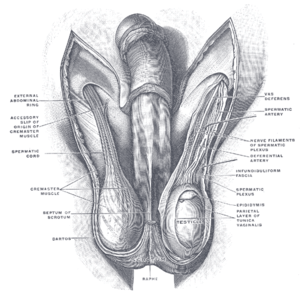Perineal raphe
| Perineal raphe | |
|---|---|
 The perineum. The integument and superficial layer of superficial fascia reflected. (Raphe visible at top.) | |
 The scrotum | |
| Details | |
| Precursor | urogenital folds |
| Identifiers | |
| Latin | raphe perinei |
| TA | A09.5.00.002 |
| FMA | 20244 |
The perineal raphe is a visible line or ridge of tissue on the human body that extends from the anus through the perineum. It is found in both males and females, and arises from the fusion of the urogenital folds.
In males, this structure continues through the midline of the scrotum (scrotal raphe) and upwards through the posterior midline aspect of the penis (penile raphe). It also exists deeper through the scrotum where it is called the scrotal septum. It is the result of a fetal developmental phenomenon whereby the scrotum and penis close toward the midline and fuse.[1]
It has been argued that the "rib" in the biblical story of Adam and Eve is actually a mistranslation of a Biblical Hebrew euphemism for baculum (penis bone), and that its removal from Adam in the Book of Genesis is a creation narrative to explain its absence in humans, as well as the presence of the raphe– as a resultant 'scar'.[2]
See also
References
- ↑ Graaff, Kent (1989). Concepts of human anatomy and physiology. Dubuque, Iowa: Wm. C. Brown Publishers. ISBN 0-697-05675-9.
- ↑ Gilbert, S. F.; Zevit, Z. (2001). "Congenital human baculum deficiency: The generative bone of Genesis 2:21-23". American Journal of Medical Genetics. 101 (3): 284–5. doi:10.1002/ajmg.1387. PMID 11424148.
This article incorporates text in the public domain from the 20th edition of Gray's Anatomy (1918)